Guest Post by Merete Mueller reposted from Tiny
Perhaps one my favorite things about our tiny house (other than falling asleep to the sound of rain on a steel roof) is that it is entirely off grid.
Christopher and I are both environmentalists of sorts, having spent chunks of our lives studying, researching, and telling stories about humans’ interactions with our natural resources and waste. Part of this tiny house experiment has always been about learning to lessen our own impact.
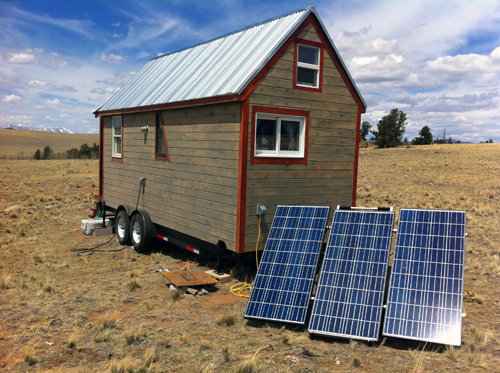
And there’s also the practical side of things: 40 miles from a major town, our tiny house doesn’t have access to a “grid” of any kind. No gas lines. No power lines. No water lines or sewage system. We’ve had to figure out our own solutions for each of these utilities.
Park County, Colorado gets an average of 246 sunny days each year, so solar power was an obvious choice for our electric needs. Throughout the building stage, Christopher looked into rigging up a system of his own design, but when we heard about the SolMan portable solar generator, we decided it was worth it to purchase a professional, pre-made solar unit than to build our own.
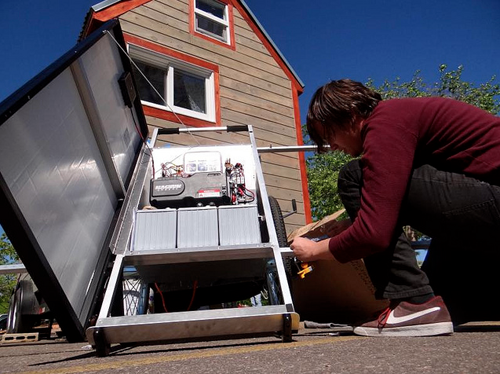
Our reasons for choosing the SolMan solar generator to power our home include:
Portability: The unit is self-contained and on wheels, designed to be easily moved from one location to the next. This means that we can move it along with our house, should we ever choose a new spot on the land, or to move it to a new location. We’d just unscrew the two solar “wings” and lift the unit into the bed of a pick-up (which, we should warn you, requires the muscles of at least 6 grown men), and we’d be on our way! The unit’s portability also means that we can use it for other purposes—like powering our video equipment on a remote shoot. And—most importantly—that we can change the positioning of the unit to track the sun throughout the day to get maximum light exposure.
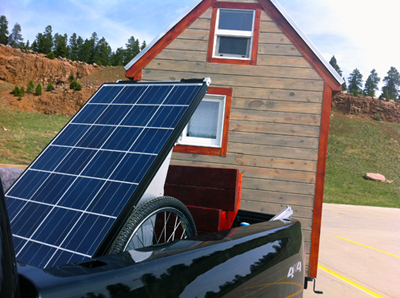
Ease of use: When it came down to designing and rigging a solar system from scratch, we decided we’d rather leave it to the professionals. Not that we couldn’t have figured it out if we wanted to, but there’s no way we could have designed anything as cohesive and high-quality as the SolMan. We literally unpacked the unit the day it arrived, flipped the inverter to “On” and it immediately started charging. To power our house, which is wired to AC, we simply rolled the SolMan over to the outlet and…plugged it in. Tada! We had power. Seriously, it was as easy as that, which after a year of building a house and realizing
that nothing is as simple as it seems, was quite refreshing.
AC/DC Flexibility: Christopher wired the house himself for AC, so that we’d have the option of plugging the house into the grid if we ever move it to an urban area. The SolMan can easily be used as either AC or DC.
Durability & Quality: The SolMan came equipped with 3,135 watt Kyocera panels, 3 gel cell deep-cycle batteries, and a Blue Sky Solar Boost charge controller. While I don’t actually understand what any of that means (which is exactly why we chose not to design the solar installation ourselves), what we do understand is that the unit is made from top-of-the-line materials. It can withstand temperatures of -70 F (important for us up in the mountains) and is weather resistant, so that we don’t have to worry about leaving it outside during Colorado thunderstorms or blizzards.
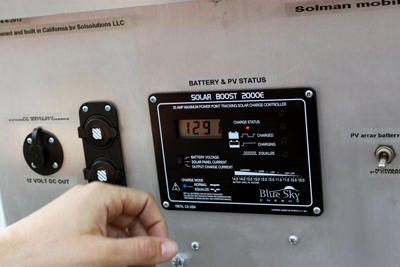
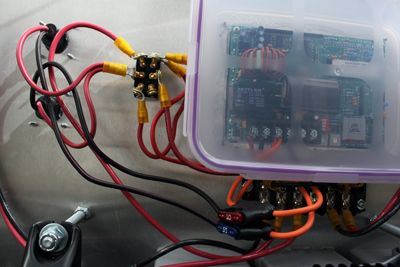
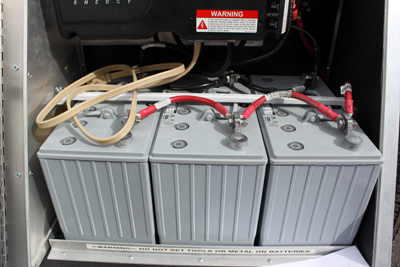
What exactly does the SolMan power?
Because of the long, cold winters in the Colorado mountains, we opted for a propane heater in our tiny house. The cooking stove is alcohol-burning (we chose not to purchase one with an oven, but propane and alcohol-fueled models with ovens for baking exist and are easy to come by). Until we decide to drill a well, there is no running water on the land. For the time being we are hauling our own water and heating it on the stove (if we do decide to install a water heater, propane-fueled models are available). So, our electricity needs are actually pretty low.
Our consistent electricity needs:
- Lights: total of 265 watts
- Small (21in. x 20in. x 18in.) high-efficiency electric fridge: 83 watts
- Charging two iPhones: 7 watts each
- Charging two MacBook Pro laptops: Merete’s 13 in. laptop is 65 watts;
- Christopher’s 17 in. laptop is 85 watts
- Small stereo hooked up to an iPhone or iPod: 50 watts
As you can see, the 1500 watt Classic SolMan system provides more than enough electricity for all of these needs (should we be running them all at once), and the 300 amp hours of battery—since it’s recommended that we only drain the batteries about halfway but no less than 60%, that leaves us with 150-200 usable amp hours—will keep us going overnight.
It also provides plenty of extra watts for our Every-So-Often electricity needs:
- Hooking up power tools for small building or repair projects: About 300 watts for a circular saw, for example.
- Charging camera batteries or other electronics: About 60 watts to charge our Canon 7D, for example.
What doesn’t the SolMan power?
The SolMan is not well suited for any electric needs that involve heating things—including toaster ovens, hot plates, electric tea pots, electric-powered heaters or water heaters. According to the SolMan website, all of these activities would require a “solar system with a large battery bank, larger inverter, and 2000 to 3000 watts of PV panels on the roof, to make a reliable system that could handle a toaster oven, electric heater or water heater.” Again, because our house is heated with propane and our cooking stove is fueled with alcohol, this is not a problem for us. If we do install a water heater it will likely be propane-fueled, and we’re fine to grill our toast and heat our tea on the stovetop.
Visit the SolMan website for the technical specs of the unit.
So far, our experience with the SolMan has been extremely positive. At a little over 9,000 feet in elevation, the sun up here is bright and strong, and even stormy days quickly charge the unit’s batteries.
On one recent cloudy day, we arrived at the tiny house and uncovered the unit (we keep it wrapped in a tarp and chained up for security purposes—we’re still working out a better storage system when we’re away) around 5pm and the unit quickly charged to capacity before nightfall, serving all of our electric needs for the rest of the evening. Indeed, our only issue with the unit has been figuring out a way to keep it safe while we’re out of town. We’re eventually planning to build a small, simple shed that we can roll the unit into when we are gone for long periods of time.
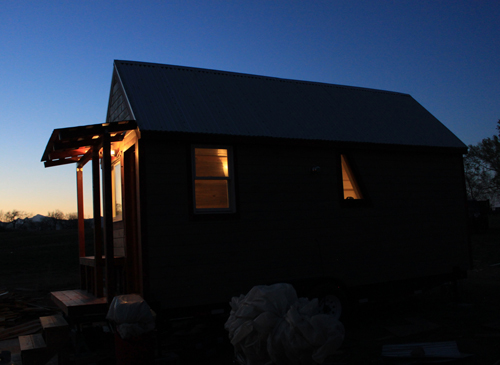
In conclusion, I’d like to stop for just a moment to express my utter amazement that we, as human beings, can harness the energy of the sun.
Is anyone else out there as awed by this as I am? Seeing the SolMan work up close still feels a bit like watching a scene from Star Trek or Spaceship Earth. Huge gratitude to the folks at Sol-Solutions, and other solar companies far and wide, for doing this work to develop easy solutions for zero-emissions, renewable power. Huzzah!
Awesome. Plan on getting one for our tiny house too. Also, no need to chain your house, just buy a hitch lock, they can be found at any Napa store. There are beefy models that are next to impossible to cut through. A chain on the other hand…
Hey Meg and Joe, we actually meant that we chain the SolMan to keep it secure while we’re away, until we build a little storage shed. You’re right–it would take a lot of chain to secure the house!
Do you have 3 of them? Or is that just 1 unit?
It is one unit with 2 extra solar panels. It can be purchased this way.
thanks!
I’m curious as to why you don’t choose a unit that can be built into your roof? That way you’d never have to haul it around, using those “6 grown men”…
Hi Anna,
Good question! We felt it was better to have the solar panels as a separate unit rather than built onto our roof for a few reasons. First, since it snows a lot in Colorado, it will be easier to brush snow off the panels if they are on the ground. Second, even though we don’t plan to move our tiny house that much, we didn’t feel that it was safe to drive it on the highway with panels on the roof. But most importantly, the fact that the SolMan is its own unit means that we can re-orient it throughout the day, so that it will always be facing the sun. I forget the exact statistic, but I think we’ll get something like 30% more energy this way. And if we ever decide to park our tiny house under a tree, we can keep the solar panels a few yards away in a sunny spot.
Curious how you deal with the septic tank (or lack thereof) issue so far off-the-grid?
Hi Francine,
We have a composting toilet, which is pretty common in tiny houses. I bet if you search “composting toilet” here on the Tiny House Blog, you’ll find some more specifics and info. We’ll be posting more about our composting toilet experiences on our blog also, once we have more of a chance to use it.
I love the idea of the composting toilet, but what do you do about urine?
You do not need a Septic Tank…You can use a Composting commode while off the grid and you can install holding tanks for water or whatever else you need one for even sewage, then drain them every now and then like if you wish to go to an RV park or Camp Ground, parking it there, you can hook it to a system like a sewage system, drain the holding tanks there and Tiny house’s water systems and electricity could be hooked up to city water and sewage if you chose to incorporate both on and off grid into your home. I’m going to include both on and off grid usage and the number of solar panels depend on how much usage of items that you are going to need power to. If your home is a larger tiny home and you have a lot of lights, big screen t.v., stereo, hair dryers, curling irons, larger refrigerator and electric stove plus multiple cell phones, ipads, ipods, etc. You would need more panels to handle all of the many different items, running them all of the time and all night long.
Please forgive me for stating the obvious but why not build a ramp that you can place over the steps (top end of the ramp comes up even to or just above the porch deck) and wheel the SolMan right into the house when you are going to be away? Also store the ramp in the house when you are going to be away (after wheeling SolMan inside). Of course the ramp will need to be longer than the steps stick out. One added advantage to the ramp is that if you move the house, the SolMan is ready to go already.
Michael, you are so right! I’m still not sure why exactly this didn’t occur to us, but I guess we had a lot on our minds with moving the tiny house for the first time. We’ll use a ramp in the future. (And while the unit is heavy, we were able to lift it, so it wasn’t really too much of an issue.) Thanks for reading!
Interesting solution, but I can think of several ways to improve it…
Firstly, having the batteries in the same unit might make it more portable, but you sacrifice temperature stability which can kill battery life. It would be fairly simple to locate all the switch gear and batteries in the house itself (insulated away from weather fluctuations) and just run the panels themselves outside with a cable to link. This would make the panels easier to move and the financial hit would be lower if it got stolen.
Second, moving it to track the sun sounds like a PITA. Tracking systems are fairly cheap, and again would work better for moving just the panels alone, not the entire rig.
Third, 265W seems like a lot for lighting. You could probably use LEDs to cut that down quite a bit?
Fourth, (and I will probably get some grief for saying this) from a sustainability angle PV is one of the last things you ever should use solar for. There is a lot more “low hanging fruit” to go after before solar for electricity. You’ll have much more of an impact on carbon footprint by using solar for water heating. Plus it means less trips to town to stock up on propane.
Last, it sounds like you connect it to your home circuit by just “plugging it into an outlet”, i.e. using one of your electrical outlets as an inlet for the home circuits. This type of backwards power feeding is prohibited under most electrical codes. For back-up generators, it is normal to have an exterior socket that is wired directly into the main panel, with a heavy duty connector and an isolator switch on the panel. Running the entire house backwards off a 15 amp outlet socket (normal rating) is asking for a fire.
Firstly,
Batteries of this size have a LOT of mass and they change temperature very slowly. If temperature became a problem, they could probably use some foil covered foam boards to insulate the batteries.
If you remove the batteries from the unit you introduce several problems. You would need a couple of large cables (large to reduce the resistance) to carry the 12V dc to the charger/inverter assembly. You make the unit almost worthless for a away-from-the-house power source since it couldn’t draw on the batteries. Without the batteries, the unit would easily be blown away in a thunderstorm. Also removing the batteries would make it MUCH easier to steal making the financial hit more likely.
Second,
If the unit charges up fully in a just a few hours, why keep moving it to track the sun if it can’t hold any more juice?
Third,
The lighting is probably the total wattage from all the light bulbs in the whole house. I am betting the list is just all the devices that use electricity in their house.
Fourth,
Yes solar hot water heating is sustainably and economical. They could also build a “solar pop can furnace”(with a solar fan of course) to heat the tiny house too. Fulfilling your current need should always be the first priority, if you need electricity for lighting at night and gadget powering it makes no sense to go get something to heat water.
Last,
In the first picture it looks like the SolMan is plugged into RV-type hookup at the end of the tiny house to bring power into the house. Pictures really are worth 1,000 words…
Overall I think the SolMan sounds like a nice portable solar power source and if it fits their needs, awesome!
I’m sorry, you are both wrong about solar hot water. I had a solar hot water system. It cost $10,000 and lasted about 20 years. Recently, I scrapped it. I did not save $500 a year. I may have saved half of that, probably less. For further discussion read this article in Green Building Advisor: http://www.greenbuildingadvisor.com/blogs/dept/musings/solar-thermal-dead
P.S. I live in eastern Massachusetts, zone 5.
I have been keeping tabs on your build and I’m really impressed with what you have done and are doing. But I wonder why you are just running 120 AC in your home for your light and power needs.
For the past 12 years I’ve called a 32 foot 5th wheel home and really don’t understand why most people wire their tiny homes for just 120 volts AC. With what’s out there for low voltage lighting and LED lighting there is no reason to use 120 volt AC for lighting if you are living off grid or on grid for that matter. If you are off grid you are wasting power going from 12 volt DC to 120 volt AC most of your lighting needs.
Yes it may have been “easier” only having to wire one power panel. But really it’s not any harder working with two voltage systems. And if you are on grid and have the power go out you will still have your 12 volt lighting if you have a battery backup is in your lighting system like most RVs do.
Where I live our power goes out at least twice a year. So having standby power in needed. I have two charging systems for when the power is out for a few days.
Great job with what you have done!
Kriss
That’s fine for a mild summer climate like Park County, CO but you’re going to need a buttload more capacity to sur-thrive off grid in Texas, the Southern States or the Desert Southwest. Night time temperatures and humidity can be anywhere from the high 70’s F with 90-100% humidity. Without some form of air conditioning, you’ll literally sweat while you sleep.
Your system looks well planned and adequate for your region of the country. I would add a portable wind charger as well. Never hurts to have back-up. I didn’t see the most important utility requirement in your summary, water and the ability to pump it. Seeing how you’re very far off grid, I’ll assume that you have a local surface water source or you’re hauling water. I takes quite a lot of power to pump water and I didn’t see that as part of your equation.
I am soooo glad you ran this post. I just went to a seminar on solar panels. I have been looking into it a bit for the future. I want to get in my house first and then go from there.
Just running the figures on the components included from the solman website.
140 watt Kyocera PV Panel kit comes with one pannel the 2 others are optional. $329
1500 watts modified or full sine-wave AC from Magum MM-AE 1500 watt inverter/charger $750
Three 100 Amp-hr sealed gel cell deep-cycle batteries $900
Blue Sky Solar Boost 2000E MPPT PV Charge Controller $225
Misc wires connecters $50
total for components $2254
The list price is $4995
I understand the benefit of packaging it all in one neat tidy 310 pound cart but really your telling me the cart with those wheels is worth the extra $2746?
Just a quick question. How do you get internet in such a remote location. Did not see any satellite dishes in the pictures. Is it affordable? Seems like a shame to have a “mac-fest” like you have with no internet. 🙂 Great story guys!!!
Doesn’t those hot spot boxes that you can purchase with a monthly service fee like from Verizon, ATT, etc. work with Satelite to create hot spots anywhere? Just asking..I had one from Verizon and it worked at my parents house which is in a very rural area when they could only get a slow version of the internet…the Verizon hot spot box that you plugged into the devise…laptop, etc. worked excellently.
Apologies in advance. I’m going to be “that guy”. I don’t understand the allure to this incredibly expensive product. As has been mentioned by kotobide this has an obscene mark up.
If your powering the house, build an insulated box on the trailer tongue for batteries and controller. build a lightweight foldable mount with wheels for the panels and if you move pick them up and put them inside. Same convenience, a fraction of the weight, fraction of the price. Need to go in the woods? take a battery put in a box, mount a cheap inverter on top. take one panel. throw in any car and go, one person setup. Portable? 310lbs is portable because it has wheels? that’s like having a safe on wheels and is in no way safely handled by one person.
If this had been DIY’d you could have added a small generator for extended cloudy days, added a dual fuel kit, to run it on gas or propane, bought an on demand propane HW heater and added additional battery with the money you would have saved.
I just don’t get it. If you built and wired your home and didn’t leave that to the “professionals” why not this? Hell if you sourced the parts and just paid an electrician to wire it you would saved a ton.
Again my apologies Merete, I just can’t stand this product and it’s insane price, and limited use. It’s too heavy and unwieldy to be moved any lengthy distance without a vehicle, and if you have to have a vehicle then just leave the batteries in the vehicle and run wires to the panels. It makes no sense to me.
Have to agree with the 2 posts above. My 1800 watt system cost less then this one and that includes 800 ah battery bank @ 24vdc. It’s a nice package, just way over priced.
I’ve often wondered why more people along the east coast don’t have a back up system along this line for hurricane season.
Quite impressive! Nice article.
Where can we find one and wbat do they cosr?
I was off-grid in a similar situation using a travel trailer and had solar setup for my needs with a system I set up myself about the same size. As krotobide above mentioned, it was far less than a pre-assembled unit and it really is just about as easy as piecing together panels, batteries, inverter and charge controller, with a little of effort to understand the capacities needed and some wiring, housing and stands. But I can see the appeal of an all in one system – but there is an immense markup on that unit.
I had two laptops and some internet equipment which I used for my job. I also had a 3-way fridge which could run on AC but found that the 100W needed for the fridge could not be powered by a system of this size. I had some shade to deal with during the day and as the season progressed towards fall, the amount of daylight was barely enough to charge the batteries. 3 or 4 days of cloudy weather and I had to conserve.
The trailer lights ran on 12v and some on 240v(I was in NZ) and the trailer was wired for both. Lighting was probably the least of my concerns.
Water pressure came from a 12v pump and an outdoor tank which I filled up by hand from a nearby stream (well, not so nearby really).
This system is adequate if you adjust your needs greatly but it won’t cover all of your needs and you will still have to be conscious of when it is sunny and when it is not.
Hi folks
Couple of things, having solar is really the way to go. i agree with some of the others. Solar is so competitive that getting the components and having a master electrician finish and OK the work would be much less expensive. In a previous life time I sold solar systems for regular homes. The final step is to have a master electrician make the final hookup and then the inspector signs off. With that thought, it would be better to mount the panels on both sides of the roof to maximize solar exposure, have your inverter and other control modules inside so you can monitor them easily and make a separate secure battery box out side. The lead distance between the solar panels and the control system is so short, there is a minimal loss of power.
One question I have, and that is internet and or TV reception. I am assuming you are using some type of dish set up. please advise on this one.
One question I have is internet and or TV reception. Are you on a dish type network?
Opps, I apologize for the obvious double sentence typo above-HS
Glad to see my fellow Coloradoans getting on with it! Very nice.
I could put together a PV System in my Sleep, so to speak, because of my background. However, if such an off-the-Shelf System works for folks, I’m all for it.
More important than all the second guessing, I wanted to make folks aware that +12 VDC or +24 VDC Well Pumping Systems are mature Technology. A Neighbor has been Off Grid for decades, and pumps via her small PV Panel. True, our local Water level is <150', but Off Grid Wells are all around; especially for remote Ranch use.
http://www.backwoodshome.com/articles2/yago91.html
Engel Fridge/Freezers aren't cheap, but they lower PV System needs/cost right up front. They address a major source of Energy consumption, and are very reliable. Along with LED Lighting, full time Off Grid Life becomes indistinguishable from Grid Tie Life; even over several Cloudy days…
http://www.amazon.com/Engel-MT35-AC-Portable-Refrigerator/dp/B004OBMCG6
i agree about the engel fridge! i’ve had this one:
http://www.campingworld.com/shopping/item/engel-fridgefreezer-15-qt-/57279
for over 2 years…tiny and compact and very low energy.
Love the house and the very detailed description of your solar system. We just added solar electric and solar hot air for daytime heating to our (not tiny) house this year. I live in MN. On the coldest days in January, we had 120 degrees of heat available in the unit.
To avoid burning propane, have you considered building a solar cooker? With your sunny location, you should have no problem making mid-day and evening meals.
Hello Ken and the TIny House community;
Great to see some thoughts going towards smaller and smarter energy use! I believe this is right in line with the Tiny House ethic.
I have read through the comments above, and will attempt to cover most of the comments I saw……
Now many of you are certainly a DYI crew, and to
those who want to do you own electric, yes, you can do a much more inexpensive job than the SolMan if you build it yourself.
SolSolution is actually advising some folks now, and doing a design for a built in small solar electric setup.
We look at it like this; there is plenty of plans for the Tiny Home available also, and you can save lots by doing it yourself.
If you look at the folks that are doing custom Tiny Home units for sale though, that are done with class and craftmanship, they are not cheap either. We do more of a high end, built to last, quality product, custom made in America in small batches.
That is why they are priced the way they are.
We have a new comparison chart showing our models, in comparison with some others out on the field, and if you really
look at the most critical battery storage and PV input ratings,
you will see where ours stands out.
http://www.sol-solutions.com/images/stories/public/PDFs/
solmanunitcomparisontocompetitors.pdf
A few other comments towards this topic;
– We have several folks now powering their tiny home with a SolMan, and it seems a good fit, with some initial power management expectations, especially once you understand to offload most heating and cooking to propane, instead of electric.
Want to just stay 12 volt DC? yes, we have a system for that also.
– Portable, self contained unit vs built in to Tiny Home?
Just depends on interior room, and most especially, ongoing orientation issues if you have PV panels fixed to roof.
You have to be in the sun, with roof pointed south always, or your system won’t function. With portable unit, park in the shade, and put SolMan in best sun, moving as needed, and just run a heavy cord to your home.
– On the moving the unit – We get a couple 2x6x8ft boards, and
make some simple ramps for getting the SolMan unit in and out of truck or vans. With a low deck vehicle, or a little elevation or curb on your load in, I can get a SolMan in and out of rig myself.
– If you have you Tiny Home wired to code, and hooked up to the grid sometimes, you DO NOT want to plug a SolMan or any other alternate electric source straight in a plug. They require a safety
bypass switch, and special plug, so you never have electric feeding back into the grid. Ask me for more details.
– The NewAir AH400 heater is a tip I got as a very efficient electric heater.
You could use this heater with the SolMan. Most of the time, folks would use heater at night, so you are on battery power, but @ 400 watts, you could run this for 5 or 6 hours, and be within the limit, as long as you have good sun the next day for a recharge.
– A great tip for a replacement of the electric hog toaster oven:
If you have a propane stove top or campstove, they make a real
simple “camp toaster rack” that will fit on a burner, and makes
great toast! I use this all the time in my off-grid trailer with no
oven. See REI or a good sporting good store. Also available
is a small stove top oven.
– And if you want to continue with the solar lifestyle, the SunOven, ( which we sell also ) will bake outside in the sun very well, and will toast, and do great cast iron kettle meals like rice and beans, with no electric or gas needed!
– We make a smaller unit, the SolMan Action Packer, that is a
different design, with a simple battery box and components, and a separate folding solar panels stand. It has less battery, a smaller inverter, and less PV input, and is even easier to move, but for $2,495, it is more affordable, if your electric needs are a little less.
– We do custom design, source, and build for any small and portable solar electric, as we are getting requests from other Tiny Home folks, and other off-grid and emergency backup situations.
We could put a kit together with the key components pre-wired,
and offer the “do-it-yourself” install to finish on your tiny home,
especially if you wanted it built in and wired to your structure.
– YES, if you need more electric sometimes than just a SolMan,
but don’t want to run the beast all the time, then consider the
hybrid power solution of a SolMan inter-tied with a gas generator.
When you need the 2000 or 3000 watts, plug in those applications directly into liquid fuel generator and run them for the time you need. This will also put a fast charge to full on the SolMan batteries. Then you can shut of the beast, and be on battery power the rest of the day and night. This also gives you the reliable power 365 days a year no matter what the weather, if you are not seeing the sun for a few days, and your batteries are down.
If you are OK just running a generator a couple hours a day to
supplement the solar, you can extend your power load and
reliability significantly for your off-grid system, and not use much gas at all.
Please ask if you have any other questions……
On my school bus RV conversion, I have a solar panel hooked up to a deep-cycle battery with a charge controller in between. I then have an inverter from the battery to everything electrical I need. This combo only cost be about $200, and even if I tripled everything involved (which would be the same as the specs for the solman), it would still only be $600. $600 as opposed to $5,000. This solman is a nice convenience, but considering its price-tag, it is really really not worth it at all. Making your own solar system is very simple and much much cheaper.
This is cool! This is a very practical house. I admire you for coming up with this very creative and brilliant idea. Thanks for sharing this with us.
Thanks for the introduction to the SolMan Portable Solar Generator. I have been considering using solar power for a while and I got overwhelmed by the the variety that sells solar generator. Your post gave me a good idea on what I should consider.